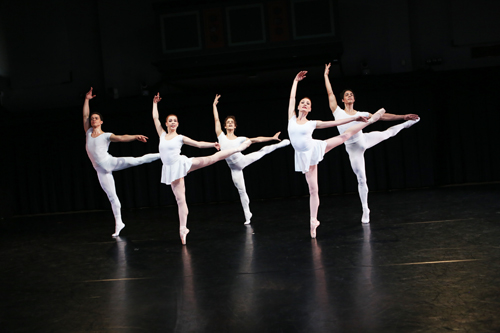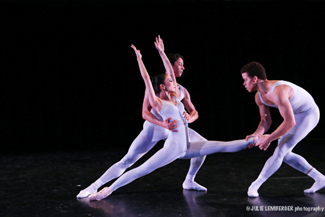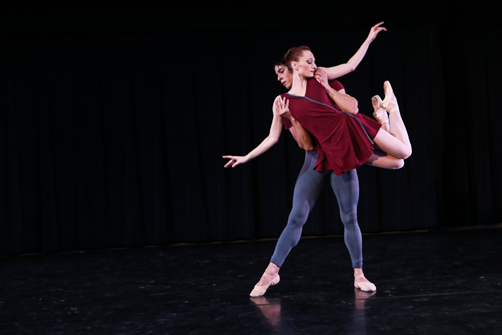Dance: A Perfect Chamber Ballet Company
All Photos by Juliet LembergerBy Dawn Lille
arttimesjournal April 21, 2018
The pleasures of dance are many and take different forms, whether as a performer or a member of the audience. For the latter, some moments are exceptional. This happened recently at a concert by the New York Theatre Ballet at the 92nd Street Y, part of this year’s Jerome Robbins Centennial celebration.
Diana Byer founded this gem of a chamber ballet company, now in its 39th year, and still heads the troupe and school. With its nine carefully trained and impeccably rehearsed dancers, who perform without any stylistic mannerisms, it has given the dance world the gift of still relevant revivals (among them works of Antony Tudor, Agnes DeMille and Vaslav Nijinsky) as well as works by outstanding contemporary creators such as the English Richard Alston.
 Septet |
Byer, who bravely faces the challenge of running a small arts organization in a major arts capitol, chose three short and rarely performed Robbins works because she found them charming and capable of adding a different feeling to the well known Robbins repertory. She points out that the entire dance world knows his work, but only through eight longer pieces. Her own teachers, Tudor and Margaret Craske, spoke often of these “little ballets,” and she strongly feels they should be danced in order to add to our knowledge of Robbins.
Septet (1982), with three men and two women in white costumes, to a 1954 Stravinsky score reduced for two pianos, used an abundance of arm gestures, some with flexed wrists, and some while seated. This lively, mischievous and sometimes silly romp seemed to be saying, “How can we make fun of something we all admire (classical ballet),” dance it in perfect form and make everyone smile with pleasure.
 Concertina |
Rondo (1980), a duet for two women to Mozart’s lush Rondo in A Minor, has long movement phrases that cut the space diagonally. By the end of this beautiful piece one had formed a real relationship with the two remarkable human dancers, Amanda Treiber and Elena Zahlmann, and wished them to remain.
Concertina. (1982), to two Stravinsky works, Concertino for String Quartet and Three Pieces for Clarinet Solo, was originally part of a quartet of small Robbins ballets. Musically, this is not the lightest of pieces. With two men and one woman, it is strong and, at times, somber. Steven Melendez performed an outstanding movement interpretation of a clarinet solo.
 |
The fourth work on the program, Wings/A Petrouchka Collage, created by the contemporary chorographer William Whitener to music by the contemporary composer Joan Tower, is a two -part work with sly references to Fokine’s ballet. Its refreshing movements and knowledgeable use of space made good use of the dancers and deserves a second viewing.
Jerome Robbins was, and still is, the quintessential American choreographer. He developed characters via movements that were often filled with humor, humanness and a touch of the folk. His dances create a community and the New York Theatre Ballet dancers were precise and exquisite in sharing this community.
The live music for every piece – always an important element in Byer’s productions - was excellent: Chloé Kiffer on violin, Michael Katz on cello, Rosa Jang on flute, Michael Scales and Melody Fader on piano and Christopher Grymes on clarinet. The music became part of the dancers’ bodies; at times they appeared to join in expanding it. The dance to the clarinet solo in Concertino was a knockout.
The intimacy in Buttenweiser Hall, where the Harkness Dance Festival takes place, suited these wonderful “gifts” to the audience. It was possible to see every nuance of movement in these intimate works.
If you were one of those who could not get into the sold out house, the Robbins ballets plus a new work by Richard Alston may be seen April 27 and 28 at 7:30PM in the small Florence Gould Hall on East 59th Street. Treat yourself.
dawnlille@aol.com
Publisher's note: The Richard Alston piece was created during NYTB’s 3 week residency in April 2018 at Kaatsbaan International Dance Center. The world premiere was at Kaatsbaan April 21 & 22, 2018.
